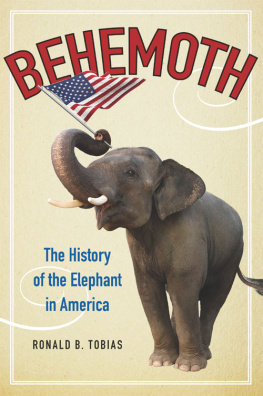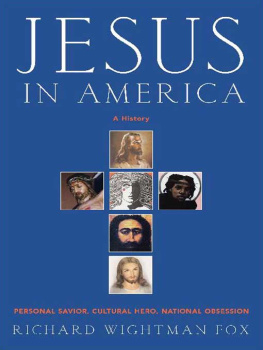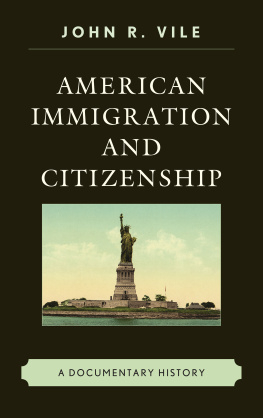M y gratitude to those who gave me their enthusiasm and advice; to those who contributed their research skills to discover the extent to which elephants have contributed to our society; and to Candy, for her patience and support.
Particular thanks go to the folks in Tennessee: Rob Atkinson, Steve Smith, Angela Spivey, Jill Moore, Christina Cooper, Dr. Susan Mikota, Hank Hammatt, and Professor Doctor Sumolya Kanchanapangka of Bangkok; the folks in Montana: Jared Berent, Catharine White, and Casey Kanode; and the folks in New York: Penn Whaling of Ann Rittenberg, Elizabeth Perrella, and Emily Cunningham at HarperCollins.
Most of all, my gratitude goes to the elephants for their needless sacrifice.
When you have got an elephant by the hind leg, and he is trying to run away, its best to let him run.
from the Boston Gazette , February 23, 1761
THE GORMAGUNT
Whereas a surprising monster was caught in the woods of Canada, near the River St. Lawrence, and has with great difficulty been tamed, and brought to the house of James ELLIOT, at Curlers Hook. This is to inform the publick, that it will be exhibited at said house till the curious are satisfied.
The monster is larger than an elephant, of a very uncommon shape, having three heads, eight legs, three fundaments, two male members, and one female pudendum on the rump. It is of various colours very beautiful, and makes a noise like the conjunction of two or three voices. It is held unlawful to kill it, and it is said to live to a great age.
The Canadians could not give a name until a very old Indian Sachem said, he remembered to have seen one when he was a boy, and his father called it a gormagunt.
O n February 17, 1796, the sailing ship America lay at anchor off St. Helena, an island in the South Atlantic Ocean, twelve hundred miles from the west coast of Africa. A junior officer noted in the ships log that the crew had spent the day loading supplies, which included among other things 23 sacks of coffee... several pumpkins and cabbages, some fresh fish for ships use, and greens for the elephant. Then he added, in large bold letters that violated the disciplined margins of his log: ELEPHANT ON BOARD.
By the time Jacob Crowninshield, the master of the America, had reached St. Helena, hed been at sea seventy-six days since leaving India. He was less than halfway across the Atlantic, and it would be mid-April before hed reach New York. Four months at sea with an elephant in the hold. We take home a fine young elephant two years old, at $450, he wrote his brothers in America. It is almost as large as a very large ox, and I dare say we shall get it home safe, if so it will bring at least $5,000.
The fledgling American merchant fleet flourished during the revolution in France in 1789. The Crowninshield family of Salem, Massachusetts, began its career in shipping and trade in the West Indies with a few small ships in the early 1790s, and by 1796 the family business had grown so much that each of the five sons of patriarch George Crowninshield captained his own vessel. With larger ships that could sail to the East Indiesand beyondthey sailed the oceans of the world in search of wealth.
When Jacob Crowninshield found an elephant calf for sale in a Calcutta market, he reasoned that if he could get the calf back from India alive, he might get ten times what hed paid for her. I suppose you will laugh at this scheme, he wrote his family, but I do not mind that, [I] will turn elephant driver... so if it succeeds, I ought to have the whole credit and honor too; of course you know it will be a great thing to carry the first elephant to America.
Crowninshield arrived in New York Harbor on April 13, 1796not quite twenty years after the signing of the Declaration of Independenceand offloaded a dazed two-year-old female elephant that hadnt seen the sun in 120 days. The calf was physically and emotionally traumatized not only from the rigors of the trip but also from being separated violently from her mother. Calves normally stay close to their mothers for two to three years, and although Crowninshields elephant could feed itself at two years, she still would have been drinking her mothers milk. Given the lack of concern or even basic understanding of care, it was a miracle she survived. Many who came after her didnt. In years following, transoceanic travelers occasionally reported seeing the bloated corpse of an elephant bobbing in the middle of the ocean.
Ten days after he arrived, Jacob Crowninshield took out advertisements in the New York papers announcing he would show an elephant in the Bulls Head Tavern, in the Battery where Beaver Street ran into Broadway. He touted the elephant as the greatest natural curiosity ever presented. Admission was the princely sum of fifty cents; half price for children.
People flocked to see the elephant. Within weeks, a Welshman from Philadelphia named Welshaven Owen offered Crowninshield ten thousand dollarstwenty times his investmentfor ownership of the elephant. Crowninshield took the money and retired from seafaring at the age of twenty-six. He entered politics and served two terms as a congressman from Massachusetts. In 1804 Thomas Jefferson nominated him as the secretary of the navy, and the Senate confirmed his appointment a year later, although Jacob declined to serve, citing his wifes poor health. In the years following he advised President James Madison on issues of trade with Great Britain, and he died in 1808 at age thirty-eight.
The junior officer on board the America who wrote ELEPHANT ON BOARD in the log also died in 1808, of yellow fever in Suriname, but not before he had fathered a girl and a boy. The boy he named after himself: Nathaniel Hathorne. His son later added a w to his last name to become Nathaniel Hawthorne, Jr., author of The Scarlet Letter and The House of the Seven Gables .
Crowninshields elephant outlived both men. She spent twenty of her first twenty-two years of life touring between Massachusetts and the Carolinas until she disappeared into the fog of history. Until then, newspapers widely reported her comings and goings. In addition, the Welshman Owen gave out handbills so everyone would know the elephant was coming. It is the most respectable Animal in the world, read his handbill, which paraphrased the French naturalist Georges-Louis Leclercthe Comte de Buffonwhod declared the elephant closest to man relative to intelligence and a soul. People slogged by foot, wagon, and horseback through snowstorms, hail storms, lightning and thunder, and rain so heavy the ground turned into sucking mud for a glimpse of Crowninshields elephant. Then they went home and told their friends and neighbors, I have seen the elephant!
For many the elephant was living scripture. As the marvelous beast of Job, Behemoth lived in the space between celestial and bestial. Her eyes, yellow as spice, embodied ancient wisdom, and her skin mapped out countless treks across the Sinai. She even swayed to a gospel only she could hear.
Crowninshields elephant was as big an attraction in its time as Buffalo Bills Wild West Show would be a century later. Or Ringling Brothers, Barnum & Bailey Circus for the first half of the twentieth century. She tramped between Charleston, Baltimore, Philadelphia, New York, Boston, and dozens of smaller communities between them, and every day from sunrise to sundown (except the Sabbath), crowds swarmed to see her. In December 1796, she appeared in Philadelphia to support the relief effort for the victims of the fire that had razed much of Savannah, Georgia. Welshaven Owen promised to donate his gate receipts for the day to Savannah. Generosity is Requested, he begged the public. By the time she appeared on stage at the New Theatre in Philadelphia in the following summerfifteen months after landing in AmericaCrowninshields elephant had grown to three thousand pounds and measured fifteen feet, eight inches from her trunk to the tip of her tail. Her attraction grew with her size. Her character also changed. Rather than a character from the Bible, more people recognized her as a fellow traveler in the American genesis story. She shared their hardships, their frustrations, and their desires. And she drank excessively. [She] drinks all kinds of spirituous liquors, reads a handbill promoting her appearance in Boston. Some days [she] has drank 30 bottles of porter, drawing the corks with [her] trunk.









